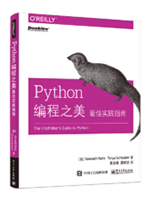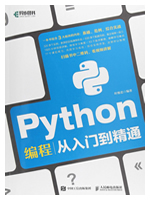《Python编程:从入门到实践》第四章:操作列表
- 发布时间:
- 作者:码农之家原创
- 点击:598
Python编程:从入门到实践
这篇文章主要知识点是关于Python编程,从入门到实践,操作列表,Python编程:从入门到实践,python编程中最常用的比较运算符实例 python编程学习np.float 被删除的问题解析 《Python编程:从入门到实践》第二章:变量和简单数据类型 《Python编程:从入门到实践》第十章:文件和异常 python编程写代码时几个坏习惯总结 的内容,如果大家想对相关知识点有系统深入的学习,可以参阅以下电子书
4-1 比萨
想出至少是三种你喜欢的比萨,将其名称存储在一个列表中,再使用for循环将每种比萨的名称都打印出来。
修改这个for循环,使其打印包含比萨名称的矩阵,而不仅仅是比萨的名称。对于每种比萨,都显示一行输出,如“I like pepperoni pizza”。
在程序末尾添加一行代码,它不在for循环中,指出你有多喜欢比萨。输出应包含针对每种比萨的消息,还有一个总结性矩阵,如“I really love pizza!”
pizza = ['banana','durian','apple']
for x in pizza:
print("I like %s pizza"%x)
print("I really love Pizza")
结果:
I like banana pizza I like durian pizza I like apple pizza I really love Pizza
4-2 动物
想出至少三种有共同特征的动物,将这些动物的名称存储在一个列表中,再使用for 循环将每种动物的名称都打印出来。
修改这个程序,使其针对每种动物都打印一个句子,如“A dog would make a great pet”。
在程序末尾添加一行代码,指出这些动物的共同之处,如打印诸如“Any of these animals would make a great pet!”这样的句子。
animals = ['dog','cat','mouse']
for x in animals:
print("A %s would make a great pet"%x)
print("Any of these animals would make a great pets")
结果:
A dog would make a great pet A cat would make a great pet A mouse would make a great pet Any of these animals would make a great pets
4-3 数到20
使用一个for 循环打印数字1~20(含)。
numbers = list(range(1,21)) for num in numbers: print(num)
结果:
1 2 3 4 5 6 7 8 9 10 11 12 13 14 15 16 17 18 19 20
4-4 一百万
创建一个列表,其中包含数字1~1 000 000,再使用一个for 循环将这些数字打印出来(如果输出的时间太长,按Ctrl + C停止输出,或关闭输出窗口)。
numbers = list(range(1,1000000)) for num in numbers: print(num)
结果:
4-5 计算1~1 000 000的总和
创建一个列表,其中包含数字1~1 000 000,再使用min() 和max() 核实该列表确实是从1开始,到1 000 000结束的。另外,对这个列表 调用函数sum() ,看看Python将一百万个数字相加需要多长时间。
numbers = list(range(1,1000001)) print(min(numbers)) print(max(numbers)) print(sum(numbers))
结果:
1 1000000 500000500000
4-6 奇数
通过给函数range() 指定第三个参数来创建一个列表,其中包含1~20的奇数;再使用一个for 循环将这些数字都打印出来.
numbers = list(range(1,21,2)) for num in numbers: print(num)
结果:
1 3 5 7 9 11 13 15 17 19
4-7 3的倍数
创建一个列表,其中包含3~30内能被3整除的数字;再使用一个for 循环将这个列表中的数字都打印出来。
numbers = list(range(3,31,3)) for num in numbers: print(num)
结果:
3 6 9 12 15 18 21 24 27 30
4-8 立方
将同一个数字乘三次称为立方。例如,在Python中,2的立方用2**3 表示。请创建一个列表,其中包含前10个整数(即1~10)的立方,再使用一个for 循 环将这些立方数都打印出来。
numbers = list(range(1,10)) result =[] for num in numbers: result.append(num**3) for num in result: print(num)
结果:
1 8 27 64 125 216 343 512 729
4-9 立方解析
使用列表解析生成一个列表,其中包含前10个整数的立方
result = [num**3 for num in range(1,11)] for x in result: print(x)
结果:
1 8 27 64 125 216 343 512 729 1000
4-10 切片
选择你在本章编写的一个程序,在末尾添加几行代码,以完成如下任务。
打印消息“The first three items in the list are:”,再使用切片来打印列表的前三个元素。
打印消息“Three items from the middle of the list are:”,再使用切片来打印列表中间的三个元素。
打印消息“The last three items in the list are:”,再使用切片来打印列表末尾的三个元素。
items1 = list(range(1,6))
print("The first three items in the list are.")
print(items1[0:3])
print("The items from the middle of the list are ")
print(items1[1:4])
print("The last three items in the list are ")
print(items1[-3:])
结果:
The first three items in the list are. [1, 2, 3] The items from the middle of the list are [2, 3, 4] The last three items in the list are [3, 4, 5]
4-11 你的比萨和我的比萨
在你为完成练习4-1而编写的程序中,创建比萨列表的副本,并将其存储到变量friend_pizzas 中,再完成如下任务。
在原来的比萨列表中添加一种比萨。
在列表friend_pizzas 中添加另一种比萨。
核实你有两个不同的列表。为此,打印消息“My favorite pizzas are:”,再使用一个for 循环来打印第一个列表;打印消息“My friend's favorite pizzas are:”,再使用一 个for 循环 来打印第二个列表。核实新增的比萨被添加到了正确的列表中。
pizza = ['banana','durian','apple']
friend_pizzas = pizza[:]
friend_pizzas.append('pumkin')
print("My favorite pizzas are:")
for pi in pizza:
print(pi)
print("My friend's favorite pizzas are:")
for pi in friend_pizzas:
print(pi)
结果:
My favorite pizzas are: banana durian apple My friend's favorite pizzas are: banana durian apple pumkin
4-12 使用多个循环
在本节中,为节省篇幅,程序foods.py的每个版本都没有使用for 循环来打印列表。请选择一个版本的foods.py,在其中编写两个for 循环,将各 个食品列表都打印出来
my_foods = ['pizza','falafel','carrot cake']
friend_food = my_foods[:]
print("My favorite foods are:")
for food in my_foods:
print(food)
print("My friend's favorite foods are:")
for food in friend_food:
print(food)
结果:
My favorite foods are: pizza falafel carrot cake My friend's favorite foods are: pizza falafel carrot cake
4-13 自助餐 自助餐
有一家自助式餐馆,只提供五种简单的食品。请想出五种简单的食品,并将其存储在一个元组中。
使用一个for 循环将该餐馆提供的五种食品都打印出来。
尝试修改其中的一个元素,核实Python确实会拒绝你这样做。
foods = ('apple','banana','orange','pea','peach')
for food in foods:
print(food)
foods[0]='tea'
结果:
apple
banana
orange
pea
peach
Traceback (most recent call last):
File "G:\practice\pythonpratice\hellow.py", line 4, in <module>
foods[0]='tea'
TypeError: 'tuple' object does not support item assignment
餐馆调整了菜单,替换了它提供的其中两种食品。请编写一个这样的代码块:给元组变量赋值,并使用一个for 循环将新元组的每个元素都打印出来。
foods = ('apple','banana','orange','pea','peach')
for food in foods:
print(food)
print("Change")
foods = ('tea','banana','pip','pea','peach')
for food in foods:
print(food)
结果:
apple banana orange pea peach Change tea banana pip pea peach
《Python编程:从入门到实践》第三章:列表简介
《Python编程:从入门到实践》第八章:函数
Python编程必学书单
《Python编程:从入门到实践》课后习题及答案
《Python编程:从入门到实践》第十章:文件和异常
以上就是本次给大家分享的全部知识点内容总结,大家还可以在下方相关文章里找到解决axios.interceptors.respon、 spring+springmvc+mybatis整合注、 vue项目中使用md5加密以及、 等python文章进一步学习,感谢大家的阅读和支持。
展开 +
收起 -








